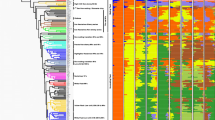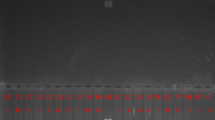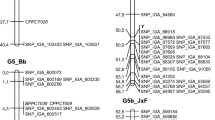Abstract
Peaches with low acidity are preferred in the market and this trait is usually selected in commercial breeding programs. A major gene (D/d) has been described for this character located on linkage group 5 of peach, where the low acid character is determined by the dominant D allele. In this paper, we analyze a collection of 231 varieties and 542 offspring to identify diagnostic markers for this character. The CPPCT040 single sequence repeat (SSR) is known to be tightly linked to D. We found that one of its alleles (193) is diagnostic for the subacid character and identified with high probability individuals with low acidity (titratable acidity <5.5 mg/l). The region around CPPCT040 was explored using 13 DNA fragments for a total of 5,297 bp, covering a length of 70.4 kbp of the peach genome. The sequenced fragments detected 19 single nucleotide polymorphisms (SNPs) and five indels. All subacid individuals shared a large haplotype (>24 kb) around CPPCT040, a region with higher than average SNPs between acid and subacid varieties. The CPPCT040 marker plus one of the SNPs identified (DH875) were used to genotype a collection of 542 seedlings, from different crosses expected to segregate for this character, which were phenotyped by tasting the fruit in the field. Data provided by both markers were always consistent and only 24 plants (4 %) did not fit the expectations. These markers and others that can be obtained from the haplotype identified can be readily used for marker-assisted selection in peach breeding.



Similar content being viewed by others
References
Abidi W, Jimenez S, Moreno MA, Gogorcena Y (2011) Evaluation of antioxidant compounds and total sugar content in a nectarine [Prunus persica (L.) Batsch] progeny. Int J Mol Sci 12:6919–6935
Aranzana MJ, Carbó J, Arús P (2003) Microsatellite variability in peach [Prunus persica (L.) Batsch]: cultivar identification, marker mutation, pedigree inferences and population structure. Theor Appl Genet 106:1341–1352
Aranzana M, Abbassi E-K, Howad W, Arus P (2010) Genetic variation, population structure and linkage disequilibrium in peach commercial varieties. BMC Genet 11:69
Aranzana M, Illa E, Howad W, Arus P (2012) A first insight into peach [Prunus persica (L.) Batsch] SNP variability. Tree Genet Genomes 8:1359–1369
Boudehri K, Bendahmane A, Cardinet G, Troadec C, Moing A, Dirlewanger E (2009) Phenotypic and fine genetic characterization of the D locus controlling fruit acidity in peach. BMC Plant Biol 9:59
Cantín CM, Gogorcena Y, Moreno MA (2009) Analysis of phenotypic variation of sugar profile in different peach and nectarine [Prunus persica (L.) Batsch] breeding progenies. J Sci Food Agric 89:1909–1917
Carver T, Thomson N, Bleasby A, Berriman M, Parkhill J (2009) DNAPlotter: circular and linear interactive genome visualization. Bioinformatics 25:119–120
Cascales AI, Costell E, Romojaro F (2005) Effects of the degree of maturity on the chemical composition, physical characteristics and sensory attributes of peach (Prunus persica) cv. Caterin. Food Sci Technol Int 11:345–352
Crisosto CH, Crisosto GM (2005) Relationship between ripe soluble solids concentration (RSSC) and consumer acceptance of high and low acid melting flesh peach and nectarine (Prunus persica (L.) Batsch) cultivars. Postharvest Biol Tec 38:239–246
Crisosto CH, Valero D (2008) Harvesting and postharvest handling of peaches for the fresh market. In: Layne, Bassi (eds) The Peach: Botany, Production and Uses, pp 575-596
Cullinan FP (1937) Improvement of Stone Fruits (Peaches). USDA Yearbook of Agriculture. pp 665-702
Dirlewanger E, Pronier V, Parvery C, Rothan C, Guye A, Monet R (1998) Genetic linkage map of peach [Prunus persica (L.) Batsch] using morphological and molecular markers. Theor Appl Genet 97:888–895
Dirlewanger E, Cosson P, Boudehri K, Renaud C, Capdeville G, Tauzin Y, Laigret F, Moing A (2006) Development of a second-generation genetic linkage map for peach [Prunus persica (L.) Batsch] and characterization of morphological traits affecting flower and fruit. Tree Genet Genomes 3:1–13
Doyle JJ, Doyle JI (1990) Isolation of plant DNA from fresh tissue. Focus 12:13–15
Etienne C, Rothan C, Moing A, Plomion C, Bodénès C, Svanella-Dumas L, Cosson P, Pronier V, Monet R, Dirlewanger E (2002) Candidate genes and QTLs for sugar and organic acid content in peach [Prunus persica (L.) Batsch]. Theor Appl Genet 105:145–159
Etienne A, Genard M, Lobit P, Mbeguie-A-Mbeguie D, Bugaud C (2013) What controls fleshy fruit acidity? A review of malate and citrate accumulation in fruit cells. J Exp Bot 64:1451–1469
Evanno G, Regnaut S, Goudet J (2005) Detecting the number of clusters of individuals using the software STRUCTURE: a simulation study. Mol Ecol 14:2611–2620
Faust M, Timon B (1995) Origin and dissemination of peach. Hortic Rev 17:331–379
Horn R, Lecouls AC, Callahan A, Dandekar A, Garay L, McCord P, Howad W, Chan H, Verde I, Main D, Jung S, Georgi L, Forrest S, Mook J, Zhenbentyayeva T, Yu Y, Kim HR, Jesudurai C, Sosinski B, Arús P, Baird V, Parffit D, Reighard G, Scorza R, Tomkins J, Wing R, Abbott AG (2005) Candidate gene database and transcript map for peach, a model species for fruit trees. Theor Appl Genet 110:1419–1428
Iglesias I, 2013 Peach production in Spain: current situation and trends, from production to consumption. Proceedings of the 4th Conference, Innovations in Fruit Growing, 75-96. Ed.: D. Milatovic, Belgrad University (Belgrard, Serbia)
Iglesias I, Echeverria G (2009) Differential effect of cultivar and harvest date on nectarine colour, quality and consumer acceptance. Sci Hortic-Amst 120:41–50
Iglesias I, Carbó J, Bonany J, Casals M, Dalmau R, Montserrat R (2005) Innovación varietal en melocotonero: especial referencia a las nuevas variedades de nectarina. Frutic Profesional 152:6–36
Illa E, Eduardo I, Audergon J, Barale F, Dirlewanger E, Li X, Moing A, Lambert P, Le Dantec L, Gao Z, Poëssel J-L, Pozzi C, Rossini L, Vecchietti A, Arus P, Howad W (2011) Saturating the Prunus (stone fruits) genome with candidate genes for fruit quality. Mol Breed 28:667–682
Lambert P, Dirlewanger E, Laurens F (2009) La sélection assistée par marqueurs (SAM) chez les arbres fruitiers: une approche prometteuse au service de l’innovation variétale. Innov Agronomiques 7:139–152
Li XW, Meng XQ, Jia HJ, Yu ML, Ma RJ, Wang LR, Cao K, Shen ZJ, Niu L, Tian JB, Chen MJ, Xie M, Arús P, Gao ZS, Aranzana MJ (2013) Peach genetic resources: diversity, population structure and linkage disequilibrium. BMC Genet 14:84
Milne I, Shaw P, Stephen G, Bayer M, Cardle L, Thomas WTB, Flavell AJ, Marshall D (2010) Flapjack-graphical genotype visualization. Bioinformatics 26:3133–3134
Monet R (1979) Transmission génétique du caractère “fruit doux” chez le pêcher. Incidence sur la sélection pour la qualité. Eucarpia Fruit Section, Tree Fruit Breeding, Angers, France, INRA, pp 273-276
Ogundiwin E, Peace C, Gradziel T, Parfitt D, Bliss F, Crisosto C (2009) A fruit quality gene map of Prunus. BMC Genomics 10:587
Pritchard JK, Stephens M, Donnelly P (2000) Inference of population structure using multilocus genotype data. Genetics 155:945–959
Quilot B, Wu BH, Kervella J, Génard M, Foulongne M, Moreau K (2004) QTL analysis of quality traits in an advanced backcross between Prunus persica cultivars and the wild relative species P. davidiana. Theor Appl Genet 109:884–897
R Core Team (2013) R: A language and environment for statistical computing. R Foundation for Statistical Computing. Vienna, Austria. http://www.R-project.org/
Reig G, Iglesias I, Gatius F, Alegre S (2013) Antioxidant capacity, quality, and anthocyanin and nutrientcontents of several peach cultivars [Prunus persica (L.) Batsch] grown in Spain. J Agr Food Chem 61:6344–6357
Sansavini S, Bassi D, Gamberini A (2006) Miglioramento varietale del pesco: genetica e genomica per nuove tipologie di frutto. Tendenze in California, Francia e Italia . Rivista di Frutticoltura 7-8
Scorza R, Mehlenbacher SA, Lightner GW (1985) Inbreeding and coancestry of freestone peach cultivars of the eastern United States and implications for peach germplasm improvement. J Am Soc Hortic Sci 110:547–552
Untergrasser A, Cutcutache I, Koressaar T, Ye J, Faircloth BC, Remm M, Rozen SG (2012) Primer3—new capabilities and interfaces. Bioinformatics 23:1289–1291
Verde I, Abbott AG, Scalabrin S, Jung S, Shu S, Marroni F, Zhebentyayeva T, Dettori MT, Grimwood J, Cattonaro F, Zuccolo A, Rossini L, Jenkins J, Vendramin E, Meisel LA, Decroocq V, Sosinski B, Prochnik S, Mitros T, Policriti A, Cipriani G, Dondini L, Ficklin S, Goodstein DM, Xuan P, Fabbro CD, Aramini V, Copetti D, Gonzalez S, Horner DS, Falchi R, Lucas S, Mica E, Maldonado J, Lazzari B, Bielenberg D, Pirona R, Miculan M, Barakat A, Testolin R, Stella A, Tartarini S, Tonutti P, Arus P, Orellana A, Wells C, Main D, Vizzotto G, Silva H, Salamini F, Schmutz J, Morgante M, Rokhsar DS (2013) The high-quality draft genome of peach (Prunus persica) identifies unique patterns of genetic diversity, domestication and genome evolution. Nat Genet 45:487–494
Xie R, Li X, Chai M, Song L, Jia H, Wu D, Chen M, Chen K, Aranzana M, Gao Z (2010) Evaluation of the genetic diversity of Asian peach accessions using a selected set of SSR markers. Sci Hortic-Amst 125:622–629
Yoshida M (1970) Genetical studies on the fruit quality of peach varieties. 1. Acidity. Bull Fruit Trees Res Stn Ser A 9:1–15
Acknowledgments
Funding for this research was partly provided from project AGL2012-40228-C02-01 from the Spanish Ministry of Economy and Knowledge. We thank Christian Fontich for providing data and plant material from the peach progenies of ASF-IRTA breeding program supported by Fruit Futur.
Data archiving statement
FASTA sequences of the subacid variety “Honey Glo” and the acid variety “Glenna” have been submitted to the NCBI GeneBank using the BankIt tool, with accession numbers KJ023869–KJ023894. Both varieties are homozygous at all loci. A table with the full list of accession numbers is presented in SM2.
Author information
Authors and Affiliations
Corresponding author
Additional information
Communicated by A. G. Abbott
I. Eduardo and E. López-Girona contributed equally to this work.
Electronic supplementary material
Below is the link to the electronic supplementary material.
Fig. S1
Probability of finding CPPCT040193 (▲) and CPPCT040199 (□) alleles at different TA (g/l) values. (PDF 30 kb)
Fig. S2
Graphical summary of a 117.5 kbp region flanking the marker CPPCT040 (in black). Green arrows represent the transcripts annotated in the peach genome (http://www.rosaceae.org/ species/prunus_persica/genome_v1.0). The amplicons sequenced in 38 peach acid and subacid varieties are highlighted in red (monomorphic), blue (polymorphic) and pink (amplicon containing the SNP DS875 genotyped by HRM). (PDF 165 kb)
ESM 1
(DOCX 33 kb)
ESM 2
(DOCX 31 kb)
ESM 3
(PDF 317 kb)
Rights and permissions
About this article
Cite this article
Eduardo, I., López-Girona, E., BatlIe, I. et al. Development of diagnostic markers for selection of the subacid trait in peach. Tree Genetics & Genomes 10, 1695–1709 (2014). https://doi.org/10.1007/s11295-014-0789-y
Received:
Revised:
Accepted:
Published:
Issue Date:
DOI: https://doi.org/10.1007/s11295-014-0789-y




